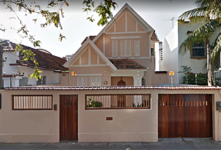Bubbington Palace
| Bubbingtom Palace | |
|---|---|
| Palácio de Bubbington | |
 | |
| General information | |
| Architectural style | Neoclassic |
| Classification | Official residence |
| Address | Nova Hermengarda, S/N |
| Town or city | Brauncastel |
| Country | |
| Current tenants | King Arthur II |
| Groundbreaking | 1899 |
| Cost | 𝒦ℳ 80 million |
| Renovation cost | 𝒦ℳ 280.000 |
| Owner | Ebenthali Royal Family |
| Affiliation | House of Bruyn |
| Height | c. 7 meters |
| Technical details | |
| Floor count | 2 |
| Floor area | 135m² |
| Other information | |
| Parking | 1 |
The Bubbington Palace (Portuguese: Palácio de Bubbington) is the official residence and administrative headquarters of the monarch of Ebenthal. Located in the Northern Borough of Brauncastel, is often at the centet of state occasions and royal hospitality, even if nominally. Originally built as a middle-class residence in what was once Brazilian territory, in 2022 the house gained the name of a palace when it was acquired and became the residence of King Arthur II of Ebenthal and the Prince Consort, who gave the royal residence its current name.
According to the purchase documents, the Bubbington Palace was built in 1899 by D. Luisa Amália in the newly founded neighborhood of Méier, in Rio de Janeiro. Between 1915 and 1928 the total ownership of Bubbington was changed with the sale of part of the land that made up the back of the house. In 1962 the property was sold to the Pinho Family who carried out modernization and retrofit works inside the house. Sixty years later, in 2022, the house was elevated to palace status by becoming the Altenburg residence of the monarch of Ebenthal, having been annexed to Ebenthal.
The palace has 2 common rooms and a small maid's room, as well as two gardens, a more decorated front and a back, in addition to a living room with an American kitchen in a modern style, an anteroom, a common bathroom and an attic.
Etimology
The name "Bubbington" came from a conversation between King Arthur II and his companion, the Prince Consort, about the British monarchy. When trying to reference the Buckingham Palace, the official residence of the British monarch, the Prince Consort said "Bubbington Palace". Although the name came about in a distracted context, the name pleased the King, who saw there a potential name for a royal residence, and decided to officially adopt it.
History
Site and construction
In 1899, the site of the future palace formed part of the Méier, middle-class and upper-middle-class neighborhood of the suburb of Rio de Janeiro that had been forming since the opening of the local train station by the Emperor of Brazil ten years earlier. The site was then purchased by D. Luisa Amália from the former owner of most of those lands, the doctor and spiritist Francisco de Menezes Dias da Cruz. A widow, D. Luisa, a middle-class former imperial chambermaid, ordered a new house to be built, seeking to move away from the house where she lived with her husband and children in the Glória neighborhood, presumably considering the memory of her husband very painful. The building began its works in March 1899 and was completed in December. Originally, the property of the house had a total of 240m² and low walls in front.
Property dismemberment
With the advent of the First World War and the resulting crisis in the national economy, the military pension received by Ms. Luisa, whose husband was presumably a veteran of the War of the Triple Alliance, began to be met with increasingly serious delays, and at an advanced age, she could no longer work, and had the help of her children. To escape the need and dependence, in 1915 D. Luisa sold 80m² of the back part of her house that was not used to her neighbor. Later, in 1921, she sold another 20m² to the same neighbor. In this second sale, however, the neighbor claimed to have paid for 25m² and accused D. Luisa of having deceived him, taking her to court. D. Luisa died in 1923 and her middle son, Filipe, who had inherited the house, took over the process. The process dragged on for another 5 years due to the infinity of appeals presented and also to the leniency of both parties involved, mainly on the part of Filipe, considering the matter futile. Finally, in 1928, the judge granted the neighbor a case, recognizing his ownership of the 5m² claimed through the payment he had previously made to the late D. Luisa.
Renovations and sale
In 1962 Maria Amália, Filipe's only child, who had died in 1958, lived in Ipanema, in the south of Rio de Janeiro, and sold the house to the architect Marcos Pinho de Moraes. Pinho, influenced by the modern architecture very present at the time, decided to adapt the house. Between 1962 and 1963 he knocked down the kitchen walls and built an island, turning it into an American kitchen, redid the ceiling with recesses and attached lamps, replaced the stairs with a more modern one and redone all the electrical installations in the house. After the renovations, the Pinho family remained living in the house until 2018, when they moved to Curitiba, making the house available for rent or sale. In 2022, amid conversations and negotiations, the house was incorporated into the city of Brauncastel as the residence of the King of Ebenthal and the Prince Consort.